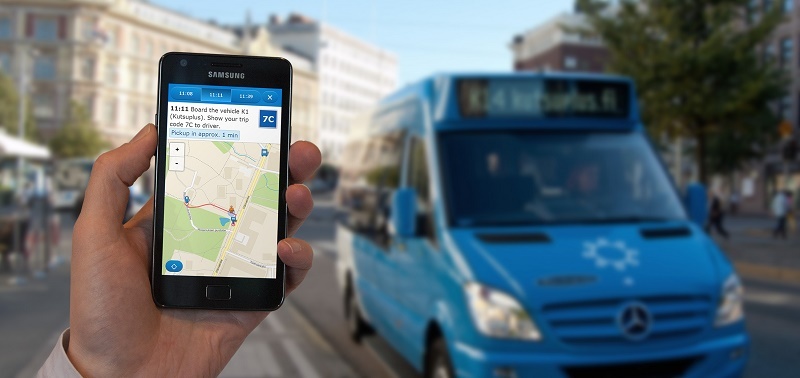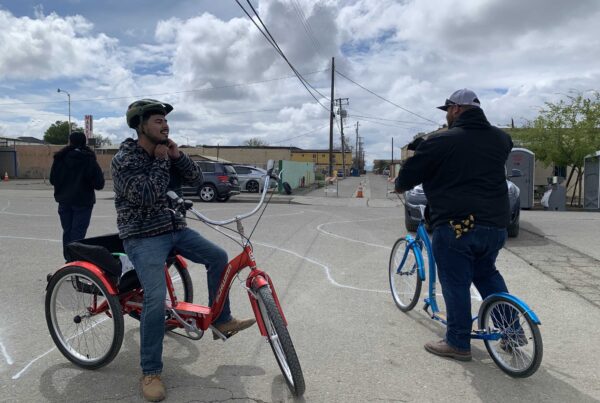Helsinki’s Kutsuplus transportation service – an on-demand, city-run system of dynamically routed minibuses that residents could hail via smartphone – is often held up as an ideal of public sector innovation. Despite the concept’s promise, however, Kutsuplus was ultimately forced to close its doors at the end of 2015.
Meanwhile, several U.S. transit agencies have been busy working to launch their own Kutsuplus-like models as the industry searches for new ways to serve areas with low population density, provide first/last mile solutions and increase ridership.
So, what happened to the original dynamic transit service, and what are the lessons for cities pursuing mobility-on-demand systems of their own?
Lesson #1: Focus on Density
Kutsuplus launched as a pilot in 2013 with 10 minibuses and later expanded to 15. But with a relatively large service area of 100 square kilometers, the service never achieved the density needed to truly function as its creators had intended.
“The system worked surprisingly well with so few vehicles, but because the concept was built with greater density in mind, we were never able to realize economies of scale,” said Teemu Sihvola, former CEO of Ajelo, the start-up that developed the tech behind Kutsuplus.
“It didn’t have an UberX feel, it was more like a suburban dial-a-ride, despite the bleeding-edge tech they were using,” said Dan Winston, vice president at Driversiti and former business development director for Split, which acquired Ajelo in 2014.
“If you have only a few vehicles covering a large region, you’re probably going to have to wait a long time for rides, and you won’t have the overlaps that make shared rides work,” said Winston. “The genius of this whole concept is finding people who are moving in the same direction and then using that to fill open seats.”
Others, too, noted that despite the concept’s focus on shared rides, when they rode Kutsuplus they were often the only passenger. The lack of paying riders also meant that each trip was more expensive to operate. And increasingly harder for HSL, Helsinki’s regional transportation authority, to justify.
Lesson #2: Market Like the Private Sector
Kutsuplus’ relatively limited ridership also tied into another issue. Despite the fanfare around the system’s launch, awareness among Helsinki residents was not as high as one would imagine.
“HSL did some public outreach, but they didn’t really push it,” said Winston. “They did a promotion offering free rides on Valentine’s Day in 2014, but outside of that I didn’t see much.”
Part of the issue may have been that HSL was hesitant to promote the system heavily with so few vehicles on the road. But while other new shared modes have often been championed by a core group of early adopters, according to Bloomberg, many people in Helsinki’s tech scene were only vaguely aware of Kutsuplus.
Transit agencies looking to promote mobility-on-demand concepts of their own might instead want to take a page out of the private sector’s playbook when it comes to marketing.
For instance, consider Uber’s ongoing campaign to deliver cars full of puppies and kittens to office workers, Lyft offering rides in Deloreans for “Back to the Future Day” or Zipcar providing micro concerts in its cars at this year’s SXSW festival. These promotions successfully grab headlines and generate increased awareness while also engaging the services’ core users.
Lesson #3: Envision and Plan for the Long Term
Kutsuplus’ most ardent advocates maintain that many of the issues that plagued the system – high cost, low ridership, limited awareness – could have been addressed in time if Helsinki would have stayed the course. Unfortunately, with Finland’s economy still reeling from the global financial crisis, HSL balked at making further investments in the system.
“Typically transportation investment decisions are made in calculations of tens of years, because no infrastructure would be profitable if you just calculate its ROI in the first year,” said Sihvola. “The same applies to new kinds of transportation services…you need to have a long-term version.”
In addition to taking a long view, Sihvola also suggests that cities clearly define their needs and analyze what kind of system best fits those requirements. A transit agency that only has three or four vehicles, for example, might not really need cutting-edge software to route its drivers.
Municipalities that are hesitant to take on the challenge of developing and operating their own mobility-on-demand service might also want to consider the option of partnering directly with a private provider. For instance, earlier this year Kansas City and microtransit provider Bridj announced the launch of a one-year pilot that will use Bridj’s dynamic routing tech to dispatch a fleet of 14-passegner vans driven by transit agency employees.
The Future of On-Demand Transit
While the grand experiment that was Kutsuplus ultimately came to end, that doesn’t necessarily mean it was a failure.
“We proved that the tech works, and that riders loved the service and were willing to pay for it,” said Sihvola. “People consistently rated Kutsuplus a 4.6 or 4.7 out of 5, which is unheard of in public transport.”
In addition to Kansas City, other cities and regions such as Salem, Oregon and California’s Santa Clara Valley are also pursuing their own Kutsuplus-like, mobility-on-demand solutions. And the list is certain to grow in the months ahead.
“I still believe, after almost 10 years, that on-demand, shared rides are the future of urban transportation,” said Sihvola. “Maybe the question is, did we build Kutsuplus before the world was ready for it?”



